A History of the County of Buckingham: Volume 3. Originally published by Victoria County History, London, 1925.
This free content was digitised by double rekeying. All rights reserved.
'Parishes: Hambleden', in A History of the County of Buckingham: Volume 3, ed. William Page (London, 1925), British History Online https://prod.british-history.ac.uk/vch/bucks/vol3/pp45-54 [accessed 23 April 2025].
'Parishes: Hambleden', in A History of the County of Buckingham: Volume 3. Edited by William Page (London, 1925), British History Online, accessed April 23, 2025, https://prod.british-history.ac.uk/vch/bucks/vol3/pp45-54.
"Parishes: Hambleden". A History of the County of Buckingham: Volume 3. Ed. William Page (London, 1925), British History Online. Web. 23 April 2025. https://prod.british-history.ac.uk/vch/bucks/vol3/pp45-54.
In this section
HAMBLEDEN
Hanbledene (xi cent.); Hamelden, Hameledene (fn. 1) (xiv cent.).
Hambleden is a large parish extending over 6,598 acres, of which 2,553 are arable, 1,308 are permanent grass and 2,034 acres (nearly one-third of the whole area) are woods and plantations. (fn. 2) The land rises sharply from 100ft. by the Thames, which forms its southern boundary, till it reaches 618 ft. in the west and north-west of the parish. The soil is light and chalky, a thick stratum of chalk being worked in various parts of the parish. The chief crops are wheat and barley.
The main road from Great Marlow to Henley runs through the southern part of the parish, and another road in the valley of the winter-bourne runs due north up the centre of the parish.
The village is about a mile from the southern end of this road. In the middle of it stands the church. The school, built by Viscount Hambleden in 1897, is outside the village on the opposite side of the road. Near the junction of the two roads the foundations of Roman buildings were noted in 1911 and have since been excavated by Mr. A. H. Cocks, F.S.A., and are to be housed in a museum near the school built by Viscount Hambleden.
The Manor House, a picturesque, many-gabled structure of dressed flint and red brick, standing to the east of the church, is the residence and property of Mr. Francis Scott-Murray. It was built in 1604 by Emanuel Scrope, afterwards Lord Scrope of Bolton and Earl of Sunderland, but was altered, restored and added to in the 19th century. The old part retains some of its original features. In the hall is some mid17th-century panelling brought from a neighbouring farm-house. The old Manor House stood to the south-east of it and is partly incorporated in the present rectory.
Yewden Manor House, the property of Viscount Hambleden, and now occupied by Mr. Philip Barnett, is at the south end of the parish. In its grounds there is an avenue of yews of great age. Yewden House and part of the water-mill on the opposite side of the Marlow road both date from the early 17th century, and a house on the south side of the Henley road, further west, is partly of the 16th century, but all have been modernized.
The village contains several cottages of early 17th-century date.
The two parsonage-houses, the Upper and the Lower, remained until 1724, (fn. 3) when Dr. Kenrick, then rector of Hambleden, built the rectory-house, the front of which remains substantially unaltered to the present day, on part of the site of the old manorhouse, utilizing a portion of its fabric. (fn. 4)
Near the mill is Hambleden Lock, newly erected in 1376, when the London bargemen lodged a complaint against the tolls exacted from them at the locks on the Thames contrary to their franchise. (fn. 5) At the head of the deep bend in the river to the west of the lock stands Greenlands, the seat of Viscount Hambleden. The original house, which stood on the river bank to the south of the site of the present mansion, was garrisoned for the king in May 1644 by a force under Colonel Hawkins. In the first week of June General Browne, in command of a Parliamentary force, was ordered against it, but various causes delayed the siege until 11 July following, when Browne's artillery overcame the resistance of the Royalists: the house 'could no longer be defended, the whole structure being beaten down by the cannon.' (fn. 6) Hawkins marched out with all the honours of war, surrendering only the house and his ordnance; and the Parliamentary general, without waiting for instructions, proceeded with the hearty goodwill of the country side to demolish what was left of the house. (fn. 7) Portions of the foundations have been uncovered from time to time, and cannon balls, relics of the siege, have been found in the garden and are now preserved at Greenlands. The nucleus of the present house consists of the smaller entrance hall entered from a pillared portico on the south side facing the river, which contains the staircase and has the library and small drawing room to the west and east. This part, built by Mr. Coventry early in the 19th century, was occupied for several years as a farmhouse. Mr. Edward Marjoribanks, the next owner, who succeeded his father as Lord Tweedmouth in 1894, built the two bow-windowed additions containing the billiard room and large drawing room on either side of this portion; he also laid out the extensive walled gardens and park. The Rt. Hon. W. H. Smith, M.P., who purchased the Greenlands estate in 1871, made great additions, building the dining room, the tower and the ranges of offices, &c., on the north side and giving the house the appearance which it now has. The main entrance on the west side opens into a square and spacious hall with the billiard room leading out of it on the right hand.
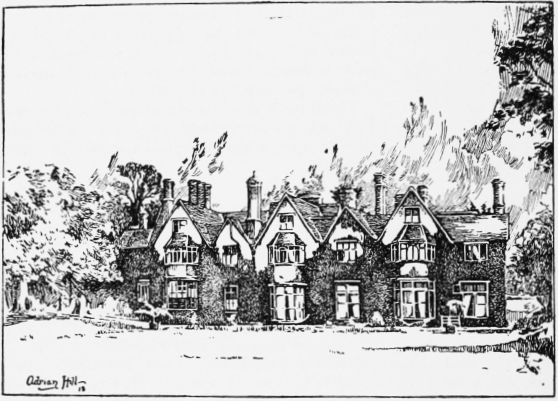
Yewden Manor House, Hambleden
Three miles north of Hambleden village is the hamlet of Skirmett, with All Saints' Church, a chapel of ease to the parish church, an infants' school and a Congregational chapel. To the west of it are Poynetts House and Wood, which derive their name from the Poynants, who were 14th-century holders of Skirmett Manor. The house is modern with a 17th-century nucleus; the foundations of an older house, burnt down in the 14th or 15th century, lie about 50 yards east of the present structure. Among the materials were some Roman brickbats, probably re-used from the ruins of a Roman house in the neighbourhood. (fn. 8) Poynetts is the residence of Mr. A. Heneage Cocks, F.S.A., who keeps in his grounds otters, wild cats and other beasts.
Frieth, (fn. 9) with St. John's Church, another chapel of ease to Hambleden Church, a parsonage, village hall and school, is 3 miles north-east of Hambleden. To the north-west of it is Little Frieth, with a few outlying cottages. About half a mile to the south-west of Frieth stands Parmoor House, the property and residence of Lord Parmoor of Frieth, K.C.V.O. It is built of brick in the Queen Anne style, and commands a fine view of the surrounding country. Further south is the hamlet called Rockwell End, which may derive its name from the family of Rocolte, of whom Thomas de la Rocolte is mentioned in the early 14th century. (fn. 10) A later form of the name is Rickoll (fn. 11) or Rockoll from 16th and 17th-century tenants.
The road between Parmoor and Hambleden village leads over Pheasant's Hill and past the hamlet of the same name, where there is a Congregational chapel, built in 1810. To the west of Pheasant's Hill, but the opposite side of the valley, on the Skirmett road, is Bacres, known as Baker's Farm in 1714. (fn. 12) After the death in 1866 of Mr. Thomas Raymond Baker, who lived there for fifty years, the property was bought by the Rt. Hon. W. H. Smith and the spelling of the name altered from Bakers to Bacres. It has been enlarged, and is now the residence of Mrs. Henry Grenfell. North of Bacres Farm is another farm called the Howe; this is bounded by a road which formerly ran from Marlow past Parmoor and which on the west of the valley is called Dudley's Lane, leading to Luxters, an old farm-house which is said to have sheltered for a night the Earl of Leicester on his way from London to Cumnor. In the eastern half of the parish on high ground about a mile south-east of the village is Burrow Farm (la Berewe alias la Burgh, xiv cent. (fn. 13); the Burrow, xvii cent.), which was bequeathed by Elizabeth Lady Periam in trust to Archbishop Laud, (fn. 14) who founded with it two scholarships in Balliol College, Oxford. (fn. 15) It is a 16th-century house with 17th-century additions and modern restorations. It retains a good many original features, including the entrance doorway (now disused), a chimney stack, windows, fireplaces and some old panelling.
Huttons Farm, east of the village, and Chisbidge (Chissebech, xiv cent.; Chesbeche, xiv cent. (fn. 16) ) Farm, near the eastern boundary of the parish, both built of flint and brick, are of early 17th-century date with later alterations.
Hambleden was the birthplace of St. Thomas de Cantelupe, (fn. 17) son of William de Cantelupe and his wife Millicent (Hambleden Manor, q.v.). He was Lord High Chancellor of England and Bishop of Hereford, and was canonized in 1320, becoming second only in popularity to St. Thomas of Canterbury among the later English saints, and was the last English saint to be recognized by the undivided Western Church. (fn. 18) Another parish worthy was Dr. Roberts, who was sequestered from the rectory of Hambleden for loyalty in 1644, (fn. 19) and at the Restoration petitioned the king for the archdeaconry of Winchester on the ground of the great misery that he had suffered in consequence. (fn. 20) The parish register notes on 17 May 1685 that Mary Wallington had a certificate to go before the king for a disease called the 'king's evil.' (fn. 21)
Palaeolithic and neolithic implements have been discovered at Skirmett (fn. 22) and in other places, particularly at Burrow and in fields near the river.
The following place-names occur in Hambleden: Bennetts, Grey, (fn. 23) Holmes (fn. 24) (xvi cent.); Adams and Colsthorpe (fn. 25) or Collmanstrop (fn. 26) (xvii cent.); Oliver's Mead (fn. 27) (xviii cent.).
MANORS
Before the Conquest HAMBLEDEN MANOR was held by Earl Algar. (fn. 28) In 1086 it was assessed at 20 hides and included in Queen Maud's lands. (fn. 29) It became attached to the barony of Gloucester (fn. 30) and was held in the 13th century by the service of one knight's fee (fn. 31) and in the 14th century in socage. (fn. 32) Later in the century it was included under the honour of Christchurch (fn. 33) and was held by grant of Edward III to the Earls of Salisbury (fn. 34) by the serjeanty of finding a tent for the king and carrying it in time of war. (fn. 35) An allusion to this service occurs in 1498. (fn. 36) The sub-tenant held Hambleden Manor of the Earls of Salisbury as part of Amesbury Manor, Wiltshire, (fn. 37) by the service of finding a standard-bearer in time of war. (fn. 38) The last mention of overlordship that has been found occurs in 1611, (fn. 39) when the service by which this manor was held of the Crown was stated to be unknown.
In the early 13th century Aumary Count of Evreux held Hambleden Manor, (fn. 40) as parcel of the inheritance of his mother Mabel, one of the daughters and co-heirs of William Fitz Robert Earl of Gloucester. (fn. 41) In 1213 Aumary's widow Millicent obtained seisin of a third of the manor in dower, the remaining twothirds passing to the next male heir Gilbert de Clare, (fn. 42) afterwards Earl of Gloucester. (fn. 43) In 1217 he gave Millicent, who had married William de Cantelupe the younger, the whole manor for her life in settlement of her other claims in dower. (fn. 44) In 1254 it was held by Richard Earl of Cornwall, (fn. 45) who in 1231 had married Isabel widow of Gilbert de Clare. (fn. 46) He died in 1272, (fn. 47) and in the same year his son Edmund married Margaret daughter of Richard de Clare Earl of Gloucester (fn. 48) and retained the manor. (fn. 49)
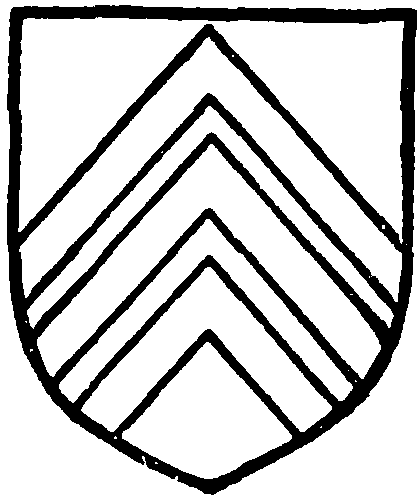
Clarf. Or three cheverons gules.
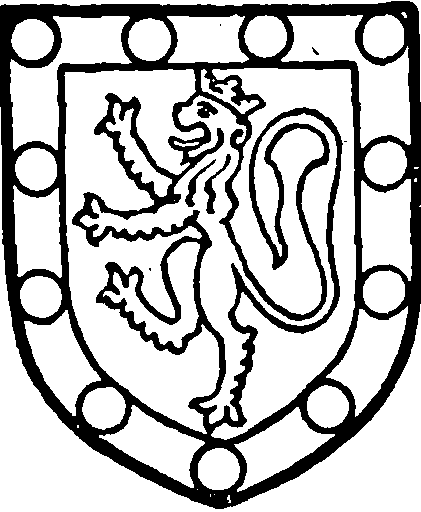
Cornwall. Argent a lion gules with a crown or in a border sable bezanty.
Edmund Earl of Cornwall appears to have resided at the manor-house of Hambleden, where he built an oratory in or before 1296. (fn. 50) In 1302 his widow was holding for her life, (fn. 51) but in 1314 Bartholomew de Badlesmere received a pardon for acquiring Hambleden Manor without licence from Gilbert de Clare, late Earl of Gloucester, (fn. 52) whose relative Margaret de Clare he had married. (fn. 53) The manor remained in his possession, (fn. 54) but when he died as a traitor in 1322 for joining Thomas Earl of Lancaster against the Despensers (fn. 55) it escheated to the Crown, (fn. 56) and in the following year was granted to the younger Hugh le Despenser. (fn. 57) In 1327 Margaret widow of Bartholomew de Badlesmere was granted Hambleden Manor to hold during the king's pleasure, (fn. 58) and in 1333 it was restored to her in accordance with the agreement made by Edward III on his accession to restore all lands confiscated for opposition to the Despensers. (fn. 59) Giles son and heir of Bartholomew de Badlesmere (fn. 60) died seised of this manor in 1338, (fn. 61) when it was assigned to his fourth sister and co-heir Margaret (fn. 62) wife of John Lord Tiptoft. (fn. 63) He held it until his death in 1367, (fn. 64) when, his wife having predeceased him, he was succeeded by their son Robert, (fn. 65) who made a settlement of Hambleden Manor in 1369. (fn. 66) At his death in 1372 it passed to Walter Hewitt and Juliane Dastyn for their lives. (fn. 67) In 1373 Juliane, then the wife of Stephen Spere, quitclaimed her right in the manor to Walter Hewitt, (fn. 68) who soon afterwards surrendered both life interests to Sir Richard Scrope, (fn. 69) first Lord Scrope of Bolton, guardian of the young daughters and co-heirs of Robert Lord Tiptoft. (fn. 70) He was still holding the manor for Juliane Spere's life in 1386, when, on the marriage of the eldest daughter and co-heir Margaret to his son Roger, (fn. 71) he with others, probably trustees, surrendered their estates in the manor to Roger and Margaret. (fn. 72) Roger le Scrope succeeded his father as Lord Scrope in 1403 (fn. 73) and died in the same year. (fn. 74) Hambleden Manor remained part of the family estates of the Scropes (fn. 75) until the death of Emanuel last Lord Scrope of Bolton and first and only Earl of Sunderland (fn. 76) in 1630, when it passed to his natural children, John, Mary, Elizabeth and Annabel. (fn. 77) John died without issue in 1646. (fn. 78) Mary with her husband Henry Carey, son of Henry second Earl of Monmouth, appears to have surrendered her share in the manor in 1647 (fn. 79) apparently to her sisters. That year Elizabeth married Thomas, later Earl Rivers, (fn. 80) and they in 1668 mortgaged their estate in the manor to Robert, (fn. 81) afterwards Sir Robert Clayton, kt., (fn. 82) to whom it was sold by their son Richard Earl Rivers (fn. 83) in 1696. (fn. 84) Meanwhile the third sister, Annabel widow of John Howe, ancestor of the Earls Howe, (fn. 85) had sold her interest in the manor to Sir Robert Clayton in 1686. (fn. 86) Hambleden Manor remained in the Clayton family, passing from Sir Robert to his nephew and heir William, afterwards Sir William Clayton, bart., (fn. 87) until the death of Sir Robert Clayton, bart., in 1799. (fn. 88) He bequeathed it in trust for sale, (fn. 89) and it was purchased in 1802 by Robert Scott of Danesfield. (fn. 90) On his death in 1808 his heir was his nephew Charles Scott-Murray (Medmenham, q.v.). His great-grandson Mr. Francis ScottMurray (fn. 91) is the present owner of Hambleden Manor.
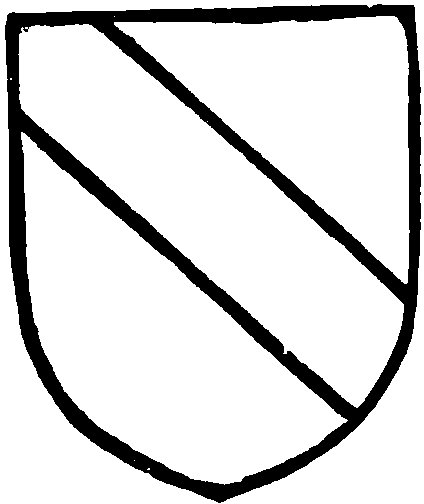
Scroff, Lord Scrope Of Bolton. Azure a bend Or.
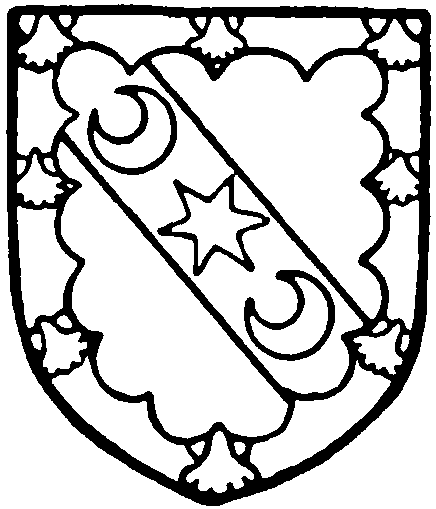
Scott. Or a bend azure with a molet between two crescents thereon and a border engrailed sable charged with scallops or.
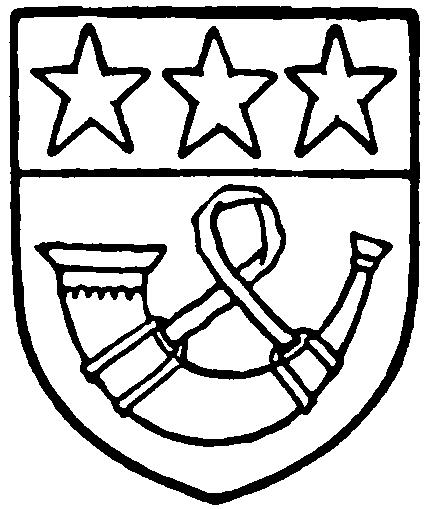
Murray. Argent a bugle-horn proper with its strings gules and a chief azure with three molets argent therein.
View of frankpledge was held for the manor from the 13th century. (fn. 92) Christmas geld was paid in 1338 amounting to £2 13s. 4d. (fn. 93) In 1315 a charter of free warren was granted to Bartholomew de Badlesmere and his heirs. (fn. 94) The right to hold a weekly market on Mondays and a yearly fair on the vigil, day and morrow of St. Bartholomew (23, 24, 25 August) was also granted in 1315. (fn. 95) The fair on St. Bartholomew's Day was being held in 1325, when Hugh le Despenser obtained an extension to the two following days, (fn. 96) but no later reference has been found to either market or fair.
The fishery at Hambleden in 1086 produced 1,000 eels (fn. 97) and was worth £1 yearly in 1338. (fn. 98) The rent of Hambleden Mill, worth £1 yearly in 1086, (fn. 99) was granted before 1236 to Keynsham Abbey, Somerset, (fn. 100) which had been founded by William Earl of Gloucester during the latter half of the 12th century. (fn. 101) Sir John Tiptoft disseised the abbot, (fn. 102) whose successor in 1396 claimed the rent (then worth £1 6s. 8d.) from Sir Richard Scrope. (fn. 103) Two water-mills are named in 1338 (fn. 104); references to them occur in the 17th and 18th centuries, (fn. 105) and one is at present worked by Messrs. C. Barnett & Sons.
Early in the 13th century half a knight's fee in Hambleden was held of the barony of Gloucester by Thomas de Santford. (fn. 106) Land in 1248 was conveyed by Adam de Pyrton, one of the heirs of Thomas de Santford or of his son Thomas, (fn. 107) to Hugh Peverel of Sampford Peverell, (fn. 108) Devonshire. (fn. 109) In 1254 he was holding it under the name of YEWDEN or EWDEN MANOR, (fn. 110) later alias GREENLANDS or MILL END. He or a relative of the same name, probably his son, was holding in 1284, (fn. 111) and two years later gave the reversion of this manor after the death of his wife Mary to Amice Peverel, his daughter, (fn. 112) and her heirs. (fn. 113) By 1302 it had passed to Henry de Montford, (fn. 114) presumably Amice's first husband, and was assigned to her in 1338 on the death of her second husband, Miles de Beauchamp. (fn. 115) She was still in possession in 1346, (fn. 116) but her son Reginald de Montford (fn. 117) in 1350 released his rights in this manor to Thomas Lord Berkeley, (fn. 118) who sold it four years later (fn. 119) to Thomas Doyley. (fn. 120) Nicholas Aumberden and Martin Chaunceaux, who were associated with him in the purchase of Yewden Manor, released to him their rights in it in 1357. (fn. 121) A settlement was made in 1366 on Thomas Doyley, his wife Alice and their heirs. (fn. 122) He died in 1384, (fn. 123) and Alice leased Yewden (fn. 124) to their son and heir William, (fn. 125) who retired there when a lawsuit had deprived him of his other estates. (fn. 126) John his elder son became a monk, but Yewden remained in the family of his younger son Richard, whose grandson John changed the chief seat to Greenlands (fn. 127) in Yewden on acquiring that estate from Sir William Stonor about 1480. (fn. 128) On his tomb in Hurley Church, where he was buried in 1492, he is described as 'a famous soldier in France.' Thomas son and heir of John Doyley was buried at Hambleden in 1545, (fn. 129) and in the following year his son John (fn. 130) received a pardon for entering Yewden Manor without licence. (fn. 131) He died seised in 1570 and was succeeded by his son Robert, (fn. 132) who was afterwards knighted. (fn. 133) He was Sheriff of Oxfordshire and died at the Black Assizes at Oxford (fn. 134) in 1577. (fn. 135) On the death of his widow Lady Periam, in 1620 (see Turville), Yewden Manor reverted to his brother and heir John, (fn. 136) who died seised in 1622. (fn. 137) His son Sir Cope Doyley, kt., on whom the rever sion of the manor had been settled in tail-male in 1605, (fn. 138) succeeded. (fn. 139) He died in 1633, when his heir was his son John. (fn. 140) He being greatly impoverished by the damage done to his estate during the siege of Greenlands sold Yewden in 1651 to Bulstrode Whitelocke. (fn. 141) After the Restoration it passed into other hands, (fn. 142) and was conveyed in 1679 by Edmund and Sarah Harrington and Richard and Winifred Chandler to John Morris. (fn. 143) Before 1687 it had been transferred to John Green, who died lord of the manor in that year. (fn. 144) His son John died in the following year. (fn. 145) He left two sisters and co-heirs, Mary, who married Thomas Coventry, (fn. 146) and Elizabeth, (fn. 147) who was unmarried in 1708. (fn. 148) The Mill End part of the estate was purchased from the heirs of Thomas and Mary Coventry by Richard Lane of Poynetts, Skirmett, who died in 1785. His eldest son and namesake (fn. 149) was Sheriff of Buckinghamshire in 1757, (fn. 150) and owned Mill End at his death in 1789. (fn. 151) His widow Ann Lane married the Rev. Thomas Hynd, (fn. 152) who was the owner in 1797. (fn. 153) It was probably their daughter Ann Hynd who was in possession in 1847. (fn. 154) Meanwhile the Greenlands part of the estate had been sold by Mr. Baker, husband of Elizabeth Green, in 1719 to Mr. Robert Ayre. (fn. 155) His daughter married Henry Stevens, and their son the Rev. Thomas Stevens, rector of Bradfield, Berks., owned the property in 1797. (fn. 156) His son the Rev. Henry Stevens, also rector of Bradfield, (fn. 157) sold it in 1801 to the Rev. Thomas Hynd, (fn. 158) who retained it for a year or two and then sold it to Mr. Steers. (fn. 159) It was purchased about 1810 by Mr. Coventry, who still owned it in 1847. (fn. 160) Fifteen to twenty years later it appears that both the Mill End and the Greenland estates were purchased by Mr. Edward Marjoribanks, who thus became owner of both moieties of Yewden Manor. (fn. 161) In 1871 it was purchased by the Right Hon. W. H. Smith, M.P., (fn. 162) whose wife shortly after his death in 1891 was raised to the peerage as Viscountess Hambleden with remainder to his male issue. (fn. 163) His son Viscount Hambleden is the present owner.
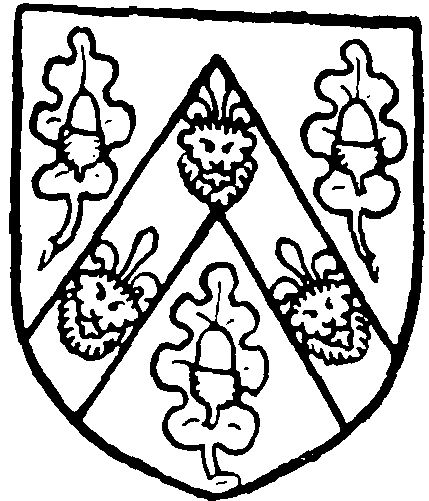
Smith, Viscount Hambleden. Argent a cheveron azure between three oak leaves vert each charged with an acorn or and with three fleurs de lis coming out of leopards' heads argent upon the cheveron.
A view of frankpledge was held at Yewden in 1254, but apparently without warrant, (fn. 164) and no later reference to it has been found.
The so-called manor of PARMOOR (Pyremere, xiv cent.; Permer, xv cent.; Pamer, Parmor, xvii cent.; Palmoor, xix cent.) appears in Hambleden in the latter half of the 15th century, but it is not regularly called a manor until fifty years later. It passed as a messuage and lands held as parcel of Hambleden Manor for a small rent and suit at court by Henry de Malyns and his wife Cecily at his death about 1324. (fn. 165) His son and heir Edmund (fn. 166) was living in 1340, when a general release dated at Hambleden was made by John, another son of Henry de Malyns, to Edmund and his son Reginald. (fn. 167) The latter, then Sir Reginald Malyns, kt., died seised in 1384, when his son and heir Edmund was aged thirty-three. (fn. 168) In the next century Parmoor passed into the possession of Sir Robert Whitingham, a supporter of the Lancastrian cause, being included in his confiscated estates, (fn. 169) which were granted by Edward IV to Sir Thomas Montgomery in 1462 for life (fn. 170) and in 1464 in fee-tail. (fn. 171) Three years later his title to Parmoor was guarded by the insertion of a saving clause in an act of restitution. (fn. 172) In 1472 the reversion of Parmoor in the event of the death of Sir Thomas Montgomery without male issue was granted to Sir Ralph Verney and his heirs. (fn. 173) His son John married Margery daughter and sole heir of Sir Robert Whitingham, and eventually obtained his wife's lands, which descended to his son Sir Ralph Verney, jun., kt. (fn. 174) He and his wife Anne in 1516 quitclaimed Parmoor Manor to Richard Janyns and his heirs. (fn. 175) Later in the century it came into the possession of the Saunders family, for in 1603 Richard Saunders conveyed it to Timothy Doyley and his heirs. (fn. 176) Later claims to this manor made by John Saunders (fn. 177) were finally settled in 1631 in favour of Timothy Doyley. (fn. 178) He belonged to a younger branch of the Doyley owners of Yewden Manor, (fn. 179) and in 1637 leased Parmoor Manor for forty years at a yearly rent of £30 to his son and heir-apparent Robert, (fn. 180) who was buried at Hambleden in 1669, (fn. 181) three years after his father's death. (fn. 182) Parmoor remained in Robert Doyley's family, passing from father to son in the direct line until the death, unmarried, of his great-grandson John Doyley. (fn. 183) He was receiver-general of light duties, and dying intestate in Seething Lane, London, in 1800, (fn. 184) was buried in the Doyley vault in Hambleden Church. (fn. 185) Parmoor Manor passed to his nephews, George Ramsey and Ambrose Stephenson, who sold it. (fn. 186) Mr. Henry Cripps, Q.C., to whom the manor belonged in 1873, (fn. 187) had occupied it prior to purchase as the tenant of Mr. William Cook of London. (fn. 188) He was succeeded in 1899 by his son, (fn. 189) now Lord Parmoor of Frieth, the present owner.
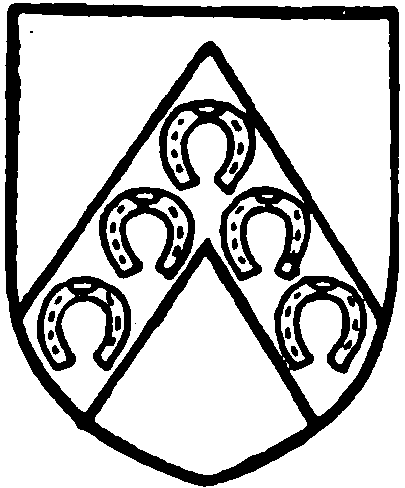
Cripps, Lord Parmoor. Or a cheveron vert with five horseshoes argent thereon.
One-sixteenth part of a fee in Hambleden was held in 1302 of the Earl of Gloucester. (fn. 190) In 1346 it was parcel of the manor of Headington (co. Oxon.), having passed to Sir Richard D'Amorie, (fn. 191) greatnephew of Roger Lord D'Amorie, the third husband of Elizabeth, one of the sisters and co-heirs of Gilbert de Clare Earl of Gloucester, slain at Bannockburn in 1314. (fn. 192) On the death of Sir Richard D'Amorie without issue in 1375 Headington Manor reverted to Elizabeth Chandos and Eleanor Colynge, sisters of Sir John Chandos, and Margaret de Annesley, his niece, (fn. 193) and the connexion between it and Hambleden appears to have been severed.
Thomas Poynant held this land, afterwards known as SKIRMETT MANOR (Skirmot, xiv cent.), as sub-tenant in 1302 (fn. 194) and Thomas Poynant and John Notebem as sub-tenants in 1346. (fn. 195) The latter surrendered his right in it in 1351 to Adam son of Thomas Poynant, (fn. 196) who five years later successfully opposed a claim to one-third of this manor in dower made by Roger Baber and his wife Joan widow of John Notebem. (fn. 197) Between 1381 and 1411 Elizabeth wife of Richard Megre had rights in the manor, (fn. 198) which she and her husband at the later date warranted against her heirs to Thomas Senycle and his heirs. (fn. 199) A reference to the vill of Skirmett occurs in 1416, (fn. 200) but the manor appears to have been dispersed among various owners. William second son of John Doyley of Greenlands (fn. 201) left his lands called Skirmetts and Bennetts by will proved in 1556 to his son Thomas on the death or marriage of his widow. (fn. 202) These afterwards came to his second son Robert, (fn. 203) father of Timothy Doyley, later of Parmoor Manor (q.v.), into which they were probably absorbed. Another portion of the manor called Poynetts was sold in 1572 under the name of Poynetts Farm by William Waller of Stoke Charity (Hants) and Wormsley in Stokenchurch, which is under 4 miles from Poynetts, to Richard Lane of Lee (Bucks.). A later Richard Lane bequeathed it to his nephew Richard Lane, who bought Mill End (q.v.). At the death of his son's widow, Ann Hynd, it was inherited by John Deane, cousin of Ann Hynd's first husband and son of Elizabeth Lane by John Deane of Howe Farm. It remained in the Deane family until purchased in 1900 from Colonel R. W. Deane, son of the Rev. R. Deane, by Mr. A. H. Cocks, the present owner. (fn. 204)
The hamlet in Hambleden called FRIETH, THE FRIETH or OLIVERS FEE (Frith, xvi cent.) in 1384 was held of Hambleden Manor for 44s. yearly and suit to one view by Sir Reginald Malyns and his wife Florence (fn. 205) (Parmoor Manor, q.v.). A later member of his family about 1429 granted Olivers Fee to one Wimbush. (fn. 206) His lands came into the possession of the Elmes family, (fn. 207) and were conveyed by one of its members in 1548 under the name of The Frith to John Doyley. (fn. 208)
The Rockolls, who held an estate in ROCKWELL END (Rockall End, early xix cent.) (fn. 209) called the farm of 'Rockholde ende' in 1577, (fn. 210) were also tenants in the 16th and 17th centuries of lands called HOO, HOW, or the HOWE-GROUND, to which references occur from the middle 13th century. (fn. 211) In 1545 these lands, lately held by Charles Duke of Suffolk (fn. 212) with the service and 20s. rent appurtenant, at one time paid by Henry Lord Scrope, were granted in fee, being then in the tenure of John Rockoll, (fn. 213) to Christopher Edmunds. (fn. 214) He transferred them in the same year to John and William Doyley. (fn. 215) They remained in John Doyley's family, following in the first half of the 17th century the same descent as Yewden Manor (q.v.). The Deanes, whose name as well as that of the Rockolls, occurs in connexion with Hambleden during the 17th century, (fn. 216) were said in 1845 to have been seated at the Howe since 1709. (fn. 217) They retained the Howe with Poynetts (q.v.), which they had inherited from the Lanes, until the end of the 19th century, when the Rev. R. Deane (fn. 218) sold the Howe to Viscount Hambleden. The earliest property held by the Deanes in this parish appears to have been at Colstrop, where they were seated as early as 1577. (fn. 219) This branch, which is distinct from that of the Howe and Poynetts, continued in possession of Colstrop, (fn. 220) and is represented to-day by Mr. Louis Deane of Colstrop Farm. The greater part of the property, however, has been sold to Mr. Henry Vivian.
Medmenham Priory owned some farms and rents in Hambleden at the Dissolution. (fn. 221) This property was granted in 1537 to Bisham Abbey, (fn. 222) and in 1546 as a parcel of land called Grey in the tenure of Thomas Grey to Thomas More of the King's household and his son Robert. (fn. 223) It has not been found possible to trace it further.
CHURCHES
The parish church of ST. MARY THE VIRGIN consists of a chancel 58 ft. by 20 ft., north vestry, north chancel aisle 12 ft. wide, south chancel aisle, north transept 27 ft. 6 in. by 15 ft., north transeptal aisle 11 ft. 6 in. wide, south transept 28 ft. by 20 ft., nave 69 ft. 6 in. by 18 ft., south porch and west tower. These measurements are all internal.
The existing building appears to have been developed from a cruciform church of the 12th century with a central tower. The outer jamb and head of a doorway, now reset in the west wall of the north transept, are the only details remaining of this date. The north transept was enlarged and an eastern aisle added early in the 13th century; about a hundred years later a rebuilding of the nave seems to have been undertaken, followed in a few years by the lengthening of the chancel and the enlargement of the south transept. A west tower of red brick, subsequently encased in flint and heightened as a memorial to Canon Ridley, was added in 1721, the original central tower having been destroyed a few years previously. The 12th-century doorway mentioned above may have been the original west doorway of the nave, the removal of which would have been necessitated by the building of the west tower. In the 19th century aisles were added to the chancel and the north vestry and south porch were built, the last from the oak of the old west gallery.
In the east wall of the chancel is a three-light window with a traceried four-centred head. There were till recently two windows in each side wall, with old rear arches and labels, probably of the 14th century, but a window on the north side has lately been blocked. The piscina, the basin of which is modern, and the sedilia, three in number, are good examples of mid-14th-century work with trefoiled ogee heads and crocketed and finialled labels, all of chalk. Beneath the east window, and visible only externally, is a blocked square-headed window of three lights. A doorway to the vestry and modern arcades of two bays opening to the chancel aisles occupy the western portion of the chancel. The chancel arch is also modern.
The 13th-century arcade opening to the eastern aisle of the north transept is of two bays with two-centred arches of two chamfered orders carried by a central circular column and small semicircular respond shafts. The transept is lighted by a modern window in the north wall and by an original 13th-century window of two lights under a two-centred containing head, with a trefoiled piercing in the spandrel, at the north-west. The 12th-century shafted jambs and roll-moulded semicircular arch set beneath this window externally belong to the doorway, the rear arch and internal jambs of which still remain in the southern half of the same wall; they were removed here on the construction of the heating chamber in the angle made by the transept with the nave. The northern half of the eastern aisle is lighted by two modern windows; the remaining portion now forms a part of the north aisle of the chancel. The windows of the south transept are all modern, though some old work may be incorporated in the internal jambs. In the east wall is a modern arch communicating with the south aisle of the chancel.
The nave communicates with the transepts by modern arched openings. In the north wall are two mid-14th-century windows, each of two cinquefoiled lights with sexfoiled tracery in a two-centred head. At the west end of this wall is a small blocked doorway of the same date with chamfered jambs and a two-centred head. The two windows in the south wall are similar in date and design to those in the opposite wall. To the west of them is the south doorway, which is also original work and of three orders. Below the sills of the windows is a moulded string-course. The modern west tower is of two stages externally. The nave roof is modern, but one of the tie-beams appears to be an old timber from the original roof re-used. The walling generally is of flint rubble with dressings of stone and chalk
The font is of the 12th century and of tub shape. Along the top is an indented moulding, and the sides are ornamented with large lozenges, each containing a floreated cross; the spandrels between the lozenges are filled with foliage approximating in type to the fleur de lis.
On the north wall of the nave is a brass to John Berde, who died in 1492, and on the west wall are the brass figures of a man in civil dress and a lady in the horned head-dress of the 15th century, with a later inscription commemorating Robert Doyley, who died in 1617, and his wife Anne, who died in 1639. On the same wall are the figures on one brass of a man and his two wives, in the costume of the early 17th century. On the north wall of the north transept, fixed on two boards, are portions of the early 16th-century brass of Robert Scrope and his wife Katherine. The inscription is in Latin and the date has not been completed. The fragments include the kneeling figure of a woman with a prayer inscribed in Latin upon a scroll above her, which appears to have belonged to a second figure facing her, two other inscribed scrolls, and four shields of Scrope quartering Tiptoft with a crescent for difference. In the north transept are also brasses to John Shipwash, who died in 1457, and his wife Joan, and to William Shipwash and Margery his wife undated but of late 15th century, and in the tower are brasses to John White and his wife Alice, 1497, Ralph Scrope, a former rector, who died in 1516, and a shield of Scrope quartering Tiptoft, Badlesmere, Clare, Scrope of Masham, and Nevill. Set on the west wall is a brass, with figures, to George Scrope, who died in 1614.
In the north wall of the chancel is a table tomb
with a panelled front containing quartered shields of
Sandys within a recess with a depressed four-centred
arch under a square inclosing moulding with shields
and foliage in the spandrels. The back of the recess
and the soffit of the arch are also panelled, the panels
of the former containing painted shields and an inscription which includes the following lines:—
'I believe in the resurrection of life
To see you again at the last day;
And now farewell Elizabeth my wife
Teach my three children, God to obeye.'
It has been supposed that this is the tomb of Henry
son of the second Lord Sandys, who died about
1555, in his father's lifetime, and left a widow
Elizabeth and three children. (fn. 224) In the tower there
is a monument with arms to Ralph Scrope, who died
in 1572. On the north side of the north aisle of
the chancel is an elaborate monument commemorating
Sir Cope Doyley, who died in 1633, and his wife
Martha, who died in 1618. Their effigies, with
those of their five sons and five daughters, are represented in alabaster. Above the monument is a crowning cornice with two allegorical figures. On the west
wall of the north transept is a monument to John
Green of Yewden Manor, who died in 1687, and to
his son, who died in the following year. A recess in
the north wall contains a stone coffin. On the north
wall of the nave is a tablet to Francis Gregory, a
former rector, who died in 1682.
Some early 16th-century panelling, traditionally said to have formed part of Cardinal Wolsey's bedstead, stands in the tower. It is divided by richly moulded and carved shafts into eight compartments, arranged in rows of four, and bearing the arms of Wolsey surmounted by a cardinal's hat and the royal arms in the left-hand panel of the upper row, with those of Foxe, Bishop of Winchester, encircled by the garter in the next panel to the right. In the left-hand lower panel is an unidentified shield; the remaining panels are richly carved, those of the upper row containing medallion heads. (fn. 225)
There are six bells: the treble by R. Phelps, 1724; the second inscribed 'Feare God 1634'; the third, 'George Deane gave this Bell 1634'; the fourth by John Warner & Sons, 1857; the fifth by Pack & Chapman, 1778; and the tenor inscribed in black letter with ornate initial letters, 'Ora Mente Pia Pro Nobis Virgo Maria.' This bell is of the early 15th century and is from the Wokingham foundry. The second and third bells are by Ellis Knight of Reading.
The plate includes a cup of 1635 presented by Elizabeth dowager Countess of Sunderland and a cover which is probably of the same year.
The registers begin in 1566.
The church of ST. JOHN THE EVANGELIST, Frieth, was built by Canon Ridley in 1848. It is of flint with stone dressings and consists of chancel, nave, south aisle added in 1872, north porch, and bellcote containing one bell. It is a chapel of ease to St. Mary.
The church of ALL SAINTS, Skirmett, was built by the Rev. C. M. Wetherall in 1886. It is of flint and brick and has a belfry containing one bell. It is also a chapel of ease to St. Mary.
ADVOWSON
Hambleden Church, which is a rectory, was valued at £23 6s. 8d. in 1291. (fn. 226) The advowson appears to have belonged to the lords of the manor from the first. (fn. 227) In 1314 the king withdrew a presentation he had made (fn. 228) in favour of one made by Bartholomew de Badlesmere pending an inquiry. (fn. 229) From this time the descent of the advowson corresponds with that of Hambleden Manor (fn. 230) (q.v.) until 1790, when it was sold by Sir Robert Clayton, bart., to Richard Troward, (fn. 231) and purchased from him by Jeremiah Smith in 1791, (fn. 232) apparently as agent for Benjamin Colborne of Bath, who died in 1793. (fn. 233) It passed from his trustees (fn. 234) before 1840 to Lord Colborne, (fn. 235) second son of Sir Matthew White-Ridley, second baronet of that name, and of Sarah daughter of Benjamin Colborne, (fn. 236) who died without surviving male issue in 1854. (fn. 237) The advowson of Hambleden passed to Canon W. H. Ridley, (fn. 238) rector from 1840 until his death in 1882. (fn. 239) It was purchased from the next owner, Mr. H. C. Ridley, (fn. 240) about 1899 by Viscount Hambleden, who is the present owner. (fn. 241)
Before 1862 the tithes had been commuted for £1, 210. (fn. 242)
Edmund Earl of Cornwall founded a chantry chapel in Hambleden, which was newly built in 1296 without licence from the bishop. (fn. 243) On this account he suspended it and also because superstitious things were venerated, miracles said to be performed and pilgrimages made there under colour of devotion. (fn. 244) Later in the year, however, the bishop withdrew the suspending order (fn. 245) and issued a licence to the Earl of Cornwall. (fn. 246) In the following year the earl obtained a licence to alienate in mortmain to Ashridge College, which he had founded in 1283, (fn. 247) a fee-farm rent in Aldbury (Herts.) for the maintenance of a chaplain. (fn. 248) The chapel appears to be that which in 1579 under the name of the late free chapel called More Chapel in Hambleden was granted to Edward Tomlinson and Anthony Page. (fn. 249)
In 1493 Reginald Davy bequeathed [money for] the rood lightand for the repair of the fabric of the church. (fn. 250)
CHARITIES
Eleemosynary Charities.
Charity of Agnes Lewyn, founded by will and comprised in deed 11 June 1577, consists of a rent-charge of 40s. yearly issuing out of a farm at Rockwell End.
The Pit House charity, comprised in deeds 19 August 1634 and 2 September 1654, consists of a house and 5 acres situate in Remenham (Berks.), let at £21 a year.
Unknown donors' charities, mentioned in the Parliamentary returns of 1786 as gifts of £20 and £50, are now represented by £74 15s. 4d. consols with the official trustees, who also hold a sum of £100 consols, arising from the sale of an acre of land called in the same Parliamentary returns the Church acre, also given to the poor by an unknown donor.
The Poor's Piece, consisting of 6 acres or thereabouts in the Lord's Field, purchased with the sum of £50 belonging to the poor and conveyed to trustees by deed 28 August 1692, let for £3 10s. a year.
The net income of these charities, amounting to about £26 a year, is applied in doles varying from 5s. to 15s. to each recipient or in articles in kind of that value.
In 1864 Ann Hynd by will bequeathed £1,000, now represented by £1,085 9s. 8d. consols with the official trustees, for the benefit of the parish church schools or the poor of the parish generally. In 1908 the dividends amounted to £27 2s. 8d. Previous to the Education Act of 1902 the income had been applied for the benefit of Skirmett infants' school.
Educational Charities.
In 1733 Augustin Varnell by will gave a rent-charge of £1 10s. yearly out of his estate in the manor of Yewden for teaching four poor children to read.
In 1762 the Rev. William Fairfax, curate of the parish, by will proved in the P.C.C. 7 June, bequeathed £100, now represented by £110 consols with the official trustees, for teaching poor children to read. The income of these charities was applied for the benefit of Hambleden and Frieth schools.
The Church of England school, founded by the Rev. H. Ridley by deed in 1806 and placed in trust in hands of the minister and churchwardens by deed of 19 December 1876, is now used as a parish room. Viscount Hambleden built a handsome new school in 1897 in memory of his father and to commemorate Queen Victoria's Diamond Jubilee.
Ecclesiastical Charities.
The Clerk's Piece consisted of a piece of land given to the parish by Lord Scrope, the rent to be expended in strewing the church with straw at Christmas and grass at Easter. It is now used in part payment of the clerk's salary. By an order of the Charity Commissioners 4 June 1913 the rector and churchwardens were appointed trustees and the income directed to be applied in payment to the parish clerk, or, failing such, to the sexton or other person performing the duties of parish clerk. The sale of the land has been authorized.
In 1882 Miss Augusta Eliza Anna Murray, by her will proved at London 18 February, bequeathed £1,333 6s. 8d. stock, now a like sum of consols with the official trustees, producing £33 6s. 8d. yearly, the dividends to be applied as a stipend for an additional curate, if any such be appointed, otherwise the income to be invested in augmentation of the principal fund.
In 1887 John Keene by will bequeathed £1,000 towards the salary of the minister of the Congregational church at Pheasant's Hill. The legacy, less duty, is represented by £900 2s. 6d. consols, standing in the names of Charles D. Keene and Alfred Keene, producing £22 10s. a year. The will contains a reverter clause in favour of certain of the legatees in the event of the church being discontinued.